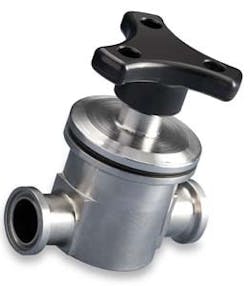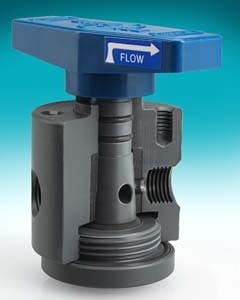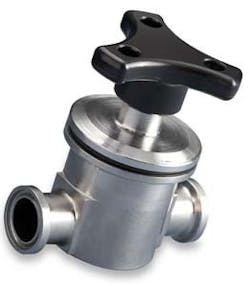An Open and Shut Case: The Latest in Valves for Bio
Here’s what’s happening in the world of valves for biopharma applications:
BioValve by BioPure (Denmead, Hampshire, UK) is a disposable product design for flow control or shut-off of silicone tubing (up to 1-1/2 inch diameter). The product goes beyond the capabilities of standard ratchet clamps, says audit manager Sean Corbett. “Most of the valves you buy can’t shut down braid reinforced tubing,“ he says. “They’re just not strong enough.”
BioValves are comprised of glass-reinforced Nylon (USP Class VI), and are suitable for autoclaving and gamma irradiation, Corbett says. (You can even get them in your corporate branding colors.) Several major manufacturers have validated and adopted the product for their global operations, he adds.
Plast-O-Matic Valves (Cedar Grove, N.J.) has introduced Series S, a compact multiport selector valve for high-purity or corrosive environments. The valves are available in 2-way, 3-way, 4-way, and 5-way configurations with a variety of flow paths, for liquid applications up to 125 psi, says marketing manager Rick Bolger. Selector valves can be "stacked" in multiple combinations for manifold applications; they can also be custom drilled to provide unique flowpaths for laboratory sampling, testing, custom mixing, and other multi-port uses.
Steriflow Valve (Cincinnati, Ohio) continues to develop its SVC/SHC series check valves, designed specifically for biopharmaceutical (and parenteral) applications. They are the first check valves to follow the valve design guidelines of ASME BPE 2007, says Karl Lutkewitte, Steriflow product manager.
A typical check valve will be spring-loaded, Lutkewitte says, and as differential pressure becomes negative the valve will close. “If you have a spring in a valve, you have to have something holding that spring, and in biopharmaceutical production that’s a no-no.” In the SVC/SHC, Lutkewitte explains, product flow goes around a central poppet, and if flow reverses, the poppet closes. “It’s a pure design,” he says. Vertical and horizontal valves are available.
The DELTA AP1 Aseptic valve series from SPX APV (Charlotte, N.C.) comes in two versions—the The Techno and the Econo—each EHEDG and 3A certified and available in a hand-operated and pneumatic actuated version, says marketing and communications manager Toni Parker. For both, the diaphragm, shaft and cone are built from one TFM piece. During opening and closing, the diaphragm is supported by a fan support system, which relieves process pressure on the diaphragm, thus protecting it against overstress caused by pressure spikes.
Asepco (Mountain View, Calif.) has released a new Inline Radial Diaphragm valve (photo), a “sibling’ to its Tank Bottom Valve. The Inline valve was designed for pharma and biotech applications, says sales and business development manager Paul Trunzo. The valve is easy to assemble and inspect, with greater diaphragm reliability—customers are telling Trunzo that they have reduced downtime from changing diaphragms and have cut maintenance costs up to 80 percent.
The Techno is can be used in sterile applications as a standard process valve, dosing valve, sample valve or as a true aseptic drain valve—e.g., welded directly onto a centrifugal pump.
Asahi/America (Malden, Mass.) has greatly expanded the range of its Type-343 Zero Dead Leg (ZDL) 3-Way diaphragm valves. Designed for high temperatures, Purad PVDF diaphragm valves can operate up to 285°F (140°C), making them suited for high-purity biopharma applications.
The Swagelok DW series weir-style diaphragm valves are designed for biopharmaceutical standards, says Swagelok’s Theresa Polachek. Forged-body shutoff valves, block-body tee patterns, close-coupled branches, and point-of-use (viking) valves are available. The DW series valves feature Kwik-Clamp and tube butt weld connections, while the diaphragms are reinforced for strength and pressure containment.
Burkert Fluid Control Systems (Ingelfingen, Germany) continues towards modularization with its Element products, including process valves, instrumentation, sensing and control into a unique simplified process package. Modular design valves, positioners and switch tops reduce wiring and pneumatic connections. A range of process control valves (globe, angle and diaphragm, in on/off and control) are available. The Element concept provides an ease of modular component integration to supply on/off control, independent control loop and/or distributive control by simply combining components with the same look, feel and performance.
The Element valves are engineered to minimize contamination risk as well, says Burkert’s Paul Ainsworth. For example, instrument air is used to flush the “back side” of the valve actuator to keep dirt, moisture, bacteria and In addition, the control housing is pressurized to keep the electronics dry.



